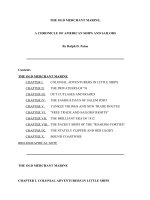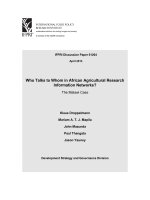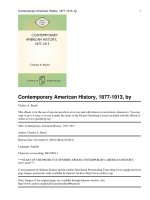Studies in African American History and Culture ppt
Bạn đang xem bản rút gọn của tài liệu. Xem và tải ngay bản đầy đủ của tài liệu tại đây (9.84 MB, 290 trang )
Studies in African American
History and Culture
Edited by
Graham Hodges
Colgate University
A Routledge Series
Troubling Beginnings
Trans(per)forming African American
History and Identity
Maurice E. Stevens
The Social Teachings of the
Progressive National Baptist
Convention, Inc., Since 1961
A Critical Analysis of the Least, the
Lost, and the Left-out
Albert A. Avant, Jr.
Giving a Voice to the Voiceless
Four Pioneering Black Women
Journalists
Jinx Coleman Broussard
Constructing Belonging
Class, Race, and Harlem’s Professional
Workers
Sabiyha Prince
Contesting the Terrain of the Ivory
Tower
Spiritual Leadership of African-American
Women in the Academy
Rochelle Garner
Post-Soul Black Cinema
Discontinuities, Innovations, and
Breakpoints, 1970–1995
William R. Grant, IV
The Mysterious Voodoo Queen,
Marie Laveaux
A Study of Powerful Female Leadership
in Nineteenth-Century New Orleans
Ina Johanna Fandrich
Race and Masculinity in
Contemporary American Prison
Narratives
Auli Ek
Swinging the Vernacular
Jazz and African American Modernist
Literature
Michael Borshuk
Boys, Boyz, Bois
An Ethics of Black Masculinity in Film
and Popular Media
Keith M. Harris
Movement Matters
American Antiapartheid Activism and
the Rise of Multicultural Politics
David L. Hostetter
Slavery, Southern Culture,
and Education in Little Dixie,
Missouri, 1820–1860
Jeffrey C. Stone
Courting Communities
Black Female Nationalism and
“Syncre-Nationalism” in the
Nineteenth-Century North
Kathy L. Glass
The Selling of Civil Rights
The Student Nonviolent Coordinating
Committee and the Use of Public
Relations
Vanessa Murphree
Black Liberation in the Midwest
The Struggle in St. Louis, Missouri,
1964–1970
Kenneth S. Jolly
When to Stop the Cheering?
The Black Press, the Black Community,
and the Integration of Professional
Baseball
Brian Carroll
Studies in African American
History and Culture
Graham Hodges, General Editor
When to Stop the Cheering?
The Black Press, the Black Community, and
the Integration of Professional Baseball
Brian Carroll
Routledge
New York & London
Routledge
Taylor & Francis Group
270 Madison Avenue
New York, NY 10016
Routledge
Taylor & Francis Group
2 Park Square
Milton Park, Abingdon
Oxon OX14 4RN
© 2007 by Taylor & Francis Group, LLC
Routledge is an imprint of Taylor & Francis Group, an Informa business
International Standard Book Number‑10: 0‑415‑97938‑2 (Hardcover)
International Standard Book Number‑13: 978‑0‑415‑97938‑2 (Hardcover)
No part of this book may be reprinted, reproduced, transmitted, or utilized in any form by any electronic,
mechanical, or other means, now known or hereafter invented, including photocopying, microfilming,
and recording, or in any information storage or retrieval system, without written permission from the
publishers.
Trademark Notice: Product or corporate names may be trademarks or registered trademarks, and are
used only for identification and explanation without intent to infringe.
Library of Congress Cataloging‑in‑Publication Data
Carroll, Brian, 1965‑
When to stop the cheering? : the black press, the black community, and the
integration of professional baseball / Brian Carroll.
p. cm. ‑‑ (Studies in African American history and culture)
Includes bibliographical references and index.
ISBN 0‑415‑97938‑2 (alk. paper)
1. Negro leagues‑‑History. 2. African American baseball players‑‑History. 3.
Baseball‑‑United States‑‑History. 4. African American press‑‑History. 5. African
American newspapers‑‑History. 6. United States‑‑Race relations‑‑History. I. Title.
GV863.A1C373 2006
796.357’6408996073‑‑dc22 2006024489
Visit the Taylor & Francis Web site at
and the Routledge Web site at
tledge‑ny.com
This edition published in the Taylor & Francis e-Library, 2007.
“To purchase your own copy of this or any of Taylor & Francis or Routledge’s
collection of thousands of eBooks please go to www.eBookstore.tandf.co.uk.”
ISBN 0-203-94413-5 Master e-book ISBN
This book is dedicated to the memory of Mom,
who embraced every race, every ethnicity, every people,
believing us all to be God’s runny-nosed children.
Her spirit was a kind of metaphysical glue that held
this project together. It is also dedicated to the memory
of Pops, for sparking a love of learning, then fanning the
flames at the nightly dinner table. For Papa, no question
was too big or strange, and every answer came with
a story he willingly and wisely told.
vii
Contents
Foreword by Larry Lester ix
Acknowledgments xiii
About the Author xv
List of Figures xvii
Introduction 1
Chapter One
The Origins of Black Baseball 7
Chapter Two
“We Are The Ship. . . . All Else The Sea” 25
Chapter Three
From Fraternity to Fracture 47
Chapter Four
Transitions 69
Chapter Five
Interventionism 89
Chapter Six
Preparing the Way 125
Chapter Seven
The Promised Land 141
Chapter Eight
Staying Away in Crowds 159
Chapter Nine
Sunset 175
Epilogue 187
Notes 195
Bibliography 249
Index 263
viii Contents
ix
Foreword
Long before the Civil Rights movement, before Brown vs. Topeka Board of
Education, before the Harlem Renaissance, before Reconstruction, before
the Civil War between the states, newspapers provided black people with
a voice. The black press was the redeeming document of black America.
This press educated an audience about social concerns and racist attitudes
while fighting against incredible odds merely to survive. This press hoped
to maintain an African American identity by revealing astonishing facts
about minority life.
This press’s call to action came on March 16, 1827, in the same year
that slavery was abolished in New York. Two Yankees, Rev. Samuel Cor-
nish and John Brown Russwurm, published a black newspaper in an un-lib-
erated America. In accordance with the racial attitudes and political climate
of the period, it was called Freedom’s Journal, and it began a tradition in
newspapers of focusing on the lives of African Americans in their churches
and colleges, in the military and society, and of course in sports, with a
focus on their struggles merely for recognition. These newspapers were, as
one documentary described them, “Soldiers Without Swords.”
Soon after, in 1847, Frederick Douglass started a paper called the
North Star, appropriately named after the beacon of freedom for those who
traveled the Underground Railroad. Douglass surmised that the mission of
his paper was “to attack slavery in all its forms and aspects; advocate Uni-
versal Emancipation; the moral and intellectual improvement of colored
people; and to hasten the day of freedom to our three million enslaved fel-
low countrymen.”
Nine score since the first black publication, Brian Carroll explores
the impact, importance, and overall necessity of a black voice in the sports
community. Just as the editorial in the first edition of Freedom’s Journal
stated, “We wish to plead our own cause. Too long have others spoken for
us. Too long has the public been deceived by misrepresentation in things
which concern us dearly,” Carroll shows how the black press represented
blacks in their own words and images in its task to break down racial bar-
riers in sports and beyond.
Often the white press promoted the white athlete and his exploits,
ignoring his equally talented black counterpart in similar sporting pursuits.
Thus the bias in the white daily newspapers created a need for a vehicle of
expression, articulation, and reporting on other professional sports, espe-
cially the national pastime—baseball. You will find in this scholarship,
black sportswriters insisting that the black ballplayer was the equal of the
white ballplayer.
Along with sports, it was not uncommon for the white press to ignore
the charity events, births, funerals, and weddings of African Americans.
Thus the need for a black newspaper was born to cover black sports and
the community’s social news. Carroll documents how the black press ful-
filled its mission, and how it used involvement in and coverage of baseball
to do it. As the number one team sport in the country, baseball became
a galvanizing influence in the inner city. It was the common ground for
a variety of discussions in barbershops, beauty salons, shoeshine parlors,
pool halls, soul food restaurants, and nightclubs.
In Carroll’s work you will find references to the Atlanta Daily World,
in 1932 the first successful black daily. Earlier, in 1909, P. Bernard Young,
Sr., started the Norfolk Journal & Guide, and in publishing it avoided
the sensationalism and “yellow journalism” prominent in many newspa-
pers at the time. Lacking the constitutional liberties of northern newspa-
pers, Young’s Journal & Guide was respected as a quality newspaper that
emphasized accuracy.
In regard to baseball, the Pittsburgh Courier and the Chicago
Defender arguably carried the most detailed information. The Defender,
which billed itself as “The World’s Greatest Weekly,” focused on games and
players from the Midwest, while the Courier tended to emphasize players
and games played along the Eastern seaboard. During World War I, the
Defender advocated the “The Great Migration” or field-to-factory move-
ment that relocated many baseball players from the South into northern
cities from roughly 1915 to 1925.
The most widely circulated black newspaper, the Courier was espe-
cially visible during World War II with its “Double V” campaign that
sought victory abroad and victory at home. The paper demanded a stop
to lynching, segregation, and the disfranchisement of black soldiers. This
campaign became the launch pad for the de-segregation of baseball, with
themes such as, “They can stop bullets on the battlefield, but not baseballs
x Foreword
on the baseball field.” Demanding full citizenship rights in freedom’s fight
was a challenge accepted by many black papers of the period.
Other noteworthy papers with great coverage of Negro league base-
ball included Indianapolis Freeman, Philadelphia Tribune, Baltimore Afro-
American, Kansas City Call, New York Age, and the New York Amsterdam
News, located in Harlem, which became the mouthpiece for one of the
largest African American communities in the country. This paper featured
some of America’s most prominent African American personalities as col-
umnists: W.E.B. Du Bois, Adam Clayton Powell, Jr., and Roy Wilkins. In
Carroll’s work you will also read about editorials written by players, man-
agers and owners like the majestic Andrew “Rube” Foster, C.I. Taylor, and
Cum Posey.
Carroll presents the Mount Rushmore of black writers from the
socially retarded period of institutional racism that shaped American minds
during the 1920s, 1930s, and 1940s. Introducing us to Hall of Fame writer
Sam Lacy of the Baltimore Afro-American, the dean of sportswriters, whose
longevity in the field is unsurpassed. Discovering Frank “Fay” Young, of
the Chicago Defender, the first full-time black sportswriter. Learning about
the creative stylist Dr. W. Rollo Wilson (a.k.a. Franklin Penn) of the Pitts-
burgh Courier and the Philadelphia Tribune, a pharmacist by trade who
was called by one writer the Red Smith of his day. And meeting Wendell
Smith of the Pittsburgh Courier, the instigator and promoter of racial par-
ity on the baseball diamond and a man rightfully honored in the Writers’
Wing of the National Baseball Hall of Fame. Smith covered the equality
field like grass seed.
Additionally, Carroll introduces you to the multi-talented Dan “Back
Door Stuff” Burley, who wrote for the Defender, Amsterdam News, Jet
and Ebony magazines, and Chester “Sez Ches” Washington of the Courier,
the Defender, and later with the Los Angeles Wave and the Sentinel, whose
articles were almost always upbeat, regardless of the hardships or attitudes
of the day. So many writers and so many agendas! They are all here, so
read, discover, and learn how the black press became the lever with which
the doors to major league baseball were pried open to blacks, providing a
start of equal opportunity in many walks of life across America.
Larry Lester
Co-founder of the Negro Leagues Museum in
Kansas City, and author of several books on
the Negro leagues, including, Baseball’s First
Colored World Series: The 1924 Meeting of
the Hilldale Giants and Kansas City Monarchs
Foreword xi
xiii
Acknowledgments
The largest measure of gratitude I give of course to my family—my bride,
Hisayo, and our daughters, Hannah, Sarah, and Mary Arden—for joining
in the journey and sharing in its swamps, valleys, jungle paths, and moun-
tain views. We did this together in true partnership. I also thank Dad for his
encouragement throughout the process, for taking me to games and away
from the microforms, and for feigning interest in bygone baseball players.
I am humbled by and indebted to my dissertation committee for their
involvement in the early stages. Tribute of the most special kind is reserved
for the memory of Margaret Blanchard. “Ma Blanch” patiently shaped
whatever I submitted into something much finer. She did this by overcom-
ing obstacles that would have stopped mere mortals in their tracks. Her
thumbprints can be found especially throughout the endnotes, for which
we shared an uncommon enthusiasm. Any mistake or oversight in this doc-
ument, of course, is wholly my own.
Chuck Stone ensured that I did not patronize, and he provided an eye-
witness and visceral connection to many of the events and people described
in this work. Harry Amana grounded my history and understanding of the
black press and pointed out a number of valuable resources. Don Shaw
asked the big-picture questions and demanded an explanation of how and
why their answers matter. The Colonel’s recommendations on the architec-
ture of this project were invaluable. Chris Lamb at the College of Charles-
ton provided essential expertise on the Negro leagues and the sportswriters
who covered them. He identified critical lines of inquiry, spotted gaps in the
research, and provided invaluable source material, some of which I proba-
bly need to return. His love for baseball and his appreciation for the sport’s
role in some of the great social dramas are wonderfully contagious.
Much is owed to Larry Lester of Kansas City, whose knowledge of
the black press, the black struggle, and of the Negro leagues is vast and
valuable, matched only by his willingness to share that knowledge. William
Simons of the State University of New York at Oneonta expertly edited two
articles that became chapters in this volume; Pat Washburn at Ohio Uni-
versity deftly edited another. The staff at the A. Bartlett Giamatti Research
Center at the National Baseball Hall of Fame, under the direction of Tim
Wiles, regularly goes the extra step that separates merely answering a ques-
tion and providing insight. Wyonella Smith of Chicago was very gracious
with her time and with her memories of her husband, Wendell Smith, and
of Jackie Robinson.
I wish to also thank Deb Aikat at the University of North Carolina at
Chapel Hill for liberally and unselfishly sharing his time, resources, advice,
energy, experience, and, perhaps most of all, laserjet printer. I could not
have made the hard turns and steep banks without regular and frequent pit
stops in his office. I especially thank him for having faith in me to do things
I had never done before, especially since failure in those situations would
have carried for him both a personal and professional price.
Bob Frank at Berry College provided unflagging support and the free-
dom a project like this requires, while Berry as an institution made it finan-
cially possible to devote a summer to revisions and editing, a subsidy for
which I am deeply appreciative. Robin Hubier proved a superhero with
logistics, which of course was no surprise to anyone who knows her. Also
on a logistical level, this project depended on the interlibrary loan services
at UNC and at Berry College, and in particular on Ariel Davis at UNC,
who kept the reels of old newspapers coming and going, and Xiaojing Zu
at Berry. The staff of Davis Library’s microfilms department, too, especially
Katherine Thornton, provided great service and a friendly face.
Finally, I thank Davis at the Rat for feeding the hungry and providing
a great good place for editing; Ben Holtzman at Routledge, who believed
in the value of this project from Day One; Diane Land for reading so many
of these words so many times; and Ross McDuffie, who fielded a lot of
ground balls without error.
xiv Acknowledgments
xv
About the Author
Brian Carroll is an assistant professor of journalism in the department of
communication at Berry College in Mount Berry, Georgia. He earned his
Ph.D. from the School of Journalism and Mass Communication at the Uni-
versity of North Carolina at Chapel Hill in June 2003. He also holds an
M.A. in political science from the University of North Carolina at Greens-
boro and a B.A. in journalism, also from UNC Chapel Hill. He lives in
Rome, Georgia.
xvii
List of Figures
Figure 1. Cartoon depicting Rube Foster and C. I. Taylor
fighting over the World Colored Championship.” 111
Figure 2. The Black Sox scandal in 1919 gave the Negro
leagues reason to celebrate “crooked” baseball’s
color bar. 112
Figure 3. “Sanity Slicker” advertisement. 113
Figure 4. Rube Foster. 114
Figure 5. Paseo Street YMCA. 115
Figure 6. The Blue Room restaurant. 115
Figure 7. Rickwood Field. 116
Figure 8. For white Birmingham Barons games in the 1950s,
blacks had to sit in this right-field section of
Rickwood Field. 116
Figure 9. Pittsburgh Courrier sports editor, Wendell Smith. 117
Figure 10. Sam Lacy, Dan Bankhead, and Wendell Smith
wait for a flight in Daytona Beach. 118
Figure 11. Satchel Paige. 119
Figure 12. Jackie Robinson. 120
Figure 13. Black teams had to resort to barnstorming to survive 121
Figure 14. Dr. J.B. Martin, longest-serving Negro league president 122
Figure 15. White Sox advertisement. 123
xviii List of Figures
1
Introduction
Kansas City’s 18
th
Street and Vine section serves as a sort of counterpoint
to Cooperstown, New York, the mythical home of the national pastime.
At that intersection sits what was Kansas City’s “colored” YMCA, now
decrepit but once a nexus of black community life on The Paseo. Inside
the Y the Negro National was born, the first enduring Negro professional
baseball league. More than 85 years since that founding in February 1920,
the building is neither venerated nor visited, even though the Negro League
Baseball Museum is just two blocks away. Waves of nostalgia don’t sweep
aficionados in like the tides, as they do in Cooperstown. No one even mows
the grass. Judging by the blighted building’s brick façade, most of the atten-
tion the old Y gets these days is of the destructive kind. Graffiti profanes
its exterior, which is punctuated with plywood substituting for glass where
windows once welcomed light. The Paseo Y’s neglect and dilapidation in
many ways represents the segregated sport’s complex relationship to its
past, and it is this past that this book explores.
The 18
th
-and-Vine street scene was so vastly different in 1920. Peeking
into the lobby of the Streets Hotel, just a block from the Paseo Y, one would
have seen well-dressed men in derby hats smoking big cigars and bantering
in the lingo of baseball. The Streets hosted Negro baseball’s luminaries and
black newspapermen who gathered in the “Paris of the Plains” to launch
the first viable all-black baseball federation, the Negro National League. In
uniting newspapermen and businessmen, the meetings forged a partnership
that sought to use baseball to force the issue of integration, an objective that
would not be accomplished until Jackie Robinson took the field as a mem-
ber of the Brooklyn Dodgers more than a quarter-century later.
In the first half of the twentieth century, during the “bleak decades of
racial exclusion,” baseball joined banking, insurance, gambling, and print-
ing in the pantheon of important African American business enterprises.
1
2 When to Stop the Cheering?
Culturally, the sport provided one of the more important summertime dis-
tractions for black communities throughout the country. Games often were
as much social events as athletic contests, particularly on Sundays, when
churches would be sure to let out early so fans could get to the ballpark.
2
Ticket buyers wore their newest and finest to Sunday doubleheaders to see
a style of play that rivaled anything major league baseball had to offer.
Historian Neil Lanctot described opening games at Philadelphia’s Hilldale
Park in 1920 as being marked by “band concerts and flag raising exercises”
and attracting “beautifully gowned ladies and Philadelphia’s ‘professional
men,’ the elite of black society.”
3
Over and above providing diversion, black baseball became a rallying
point for the communities that supported it, engendering pride and show-
casing and symbolizing black achievement. The sport created, in the words
of Jules Tygiel, “a sphere of style and excitement that overlapped with
the worlds of black business, politics, religion, and entertainment.”
4
Prior
to Robinson’s breakthrough in Brooklyn, baseball brought more blacks
together on a regular basis than any other endeavor.
5
On opening day in 1938, for example, the Kansas City Monarchs and
their rivals, the Chicago American Giants, were greeted in Kansas City by a
parade of 500 decorated cars, two marching bands, local law enforcement,
and the renowned Monarch Booster Club, which included in its member-
ship black business, church, and fraternal organization leaders.
6
Tickets to
Monarchs games could be purchased at, among other establishments, the
Monarch Billiard Parlor, Stark’s Newspaper Stand, the Panama Taxi Stand,
and McCampbell’s and Hueston’s Drug stores. Pictures of Monarch play-
ers, advertisements for games, and footage of the opening day ceremonies
were offered as part of the daily fare at the city’s Elbon and Lincoln movie
theaters.
7
Baseball’s leaders were the black communities’ business leaders. As an
entrepreneur, “Race man,” and advocate for his people, Andrew “Rube”
Foster, principal founder of the Negro National League, was also a promi-
nent Chicago businessman who dealt with discrimination by creating a
vibrant, job-producing black institution.
8
His success and the nobility of his
aims were celebrated on his death, when 3,000 mourners attended funeral
services for him in December 1930. Foster’s body lay in state, like a presi-
dent or prime minister, for three days.
9
The drama of baseball’s re-integration offers an opportunity to exam-
ine the ways in which the issues of race, segregation, and civil rights were
covered by the black press, as well as how they were not covered, and com-
pare them to coverage in the white mainstream press. Specifically, this book
attempts to document the close, often conflicted relationship between the
black press and black baseball beginning with the Negro National League
in 1920 and finishing with the dissolution of the last league of substance,
the Negro American, which faded from existence in the 1950s. Explored is
the multidimensional relationship newspapers had with baseball, including
their treatment of and relationships with baseball officials, team owners,
players, and fans. Over time, these relationships changed, resulting in shifts
in coverage that can be described as moving from brotherhood to paternal-
ism, then from paternalism to nostalgic tribute and even regret.
The nostalgia evidenced in the writings of the black sportswriters of
the mid-1950s and later point to a process and a problem central to Ameri-
can culture, particularly in the racially charged 1950s and 1960s. To pre-
serve the flower—in this case the Negro leagues—would have been to limit
the opportunities of blacks and to perpetuate disenfranchisement and sub-
ordination. Achieving larger societal goals of integration and equal opportu-
nity and access, however, came with the pain of watching the flower die on
the vine, a pain not unlike that caused by the sacrifice of other once-vibrant
black institutions, such as those in education and entertainment. This book
seeks to chart, describe, and analyze this deliberate but wrenching sacrifice
of Negro league baseball for those larger societal goals, a sacrifice that rep-
resents in many ways W. E. B. Du Bois’s notions of a double-consciousness,
or the idea that blacks have to reconcile the desire for assimilation with the
equal desire to preserve their distinctive African heritage and culture. This
attempt at reconciliation produces what Du Bois called the “double life”
that every American Negro of the twentieth century experienced.
10
The black press of the 1920s through 1950s served many roles in
American society. Called a “fighting press,” black newspapers campaigned
for the integration of society, for equal access and opportunity, and for full
participation in the democratic experiment. The black press also served as
the black community’s voice and, by its expression, as a preservative of
that community’s identity, or what one veteran of the black press called
“negritude.”
11
The newspapers imbued African Americans with a sense of
purpose and destiny, functioning as an “instrument of social change, enter-
prise, artistic self-esteem, and racial solidarity,” wrote a historian of the
black press.
12
In fulfilling these roles the newspapers contributed to the
development of a national black consciousness.
13
Baseball coverage provides a convenient lens through which to exam-
ine these roles and their facets. In the arena of sport, all of the black press’s
purposes and its plans to carry out those purposes are on microcosmic dis-
play. The Negro leagues populated an all-black professional baseball world
that was a vital thread in the tapestry of northern, urban black life during
the period under study.
Introduction 3
4 When to Stop the Cheering?
Specifically, this book seeks to explore and analyze the very con-
flicted, multidimensional relationship the press had with the Negro leagues,
including its officials, team owners, players, and fans. When black papers
such as the Pittsburgh Courier, Chicago Defender, Afro-American, New
York Amsterdam News, and Indianapolis Ledger, the same newspapers
that helped found the Negro leagues, began filling their sports pages with
news of Jackie Robinson and his Brooklyn Dodgers beginning in 1947, lit-
tle room or resource remained to spend on Negro league teams. The once-
strong ties of brotherhood in the fight for equality and full access broke
apart as the black newspapers neared their goal. The stance of the black
papers towards the leagues became paternalistic and highly critical, and it
remained highly critical through the 1940s. Only after the Negro leagues
had largely faded in the 1950s did newspapermen show signs of nostal-
gia and, in a few instances, hints of regret, a posture that was perhaps the
result of integration’s toll on the importance of the black press itself.
These transitions, from brotherhood to paternalism to grandfatherly
nostalgic tribute, are examined, as are the costs of integration. American
society claims allegiance to the ideals of integration and equal access, but
often it fails to make an accounting of the social and economic costs to the
black community of fulfilling these ideals. When viewed as a whole, the
coverage dramatizes how one-sided integration has been for the most part.
In the case of baseball, it benefited the white-owned major league teams at
the expense of the black-owned, black-run Negro leagues. The expectation
that blacks had to move into the mainstream was not challenged; the cost
to the black community in terms of its own cultural institutions was not
calculated or even considered.
The black community’s sacrifices meant a loss of control. When orga-
nized as the Negro leagues, black baseball controlled its own destiny and
made its own rules. As members of an integrated baseball scene, black ball
players had to play by someone else’s rules and always as a minority. This
aspect of integrated baseball has changed little, in fact. Major league base-
ball did not hire a black field manager until 1975, when the Cleveland Indi-
ans tapped former playing great Frank Robinson. The Chicago Cubs, as just
one example, did not hire its first black skipper (Don Baylor) until 1999.
The Negro National boasted seven black owners, which is exactly seven
more than the number of blacks who have owned major league teams.
There remain in contemporary baseball fewer opportunities for blacks
off the field than there were at any point on the Negro leagues’ topsy-
turvy timeline, and the thoroughly segregated state of baseball for such a
long period is a significant reason why. Segregation allowed for and even
required institutional, economic, and political forces that had their stake
almost exclusively in the black community. Paired with white interests in
preserving and pursuing this thoroughly separate development, assimila-
tion and integration were structurally impossible.
A few disclaimers might aid the reader. First, the term Negro league
is used in this book to refer to primarily but not exclusively to three fed-
erations of black teams—the Negro National League, the Negro American
League, and the Eastern Colored League. These were the “big leagues” of
black baseball, qualitatively and administratively different from the many
semi-pro and amateur Negro leagues, such as the Negro Southern League
and the Texas Oklahoma Louisiana League, among others. This scope also
for the most part excludes the hundreds of independent and barnstorm-
ing black baseball teams, even though virtually all black teams, including
Negro league teams of the first rank, extensively barnstormed in order to
survive.
14
Second, the term “integration” admittedly is problematic. For the sake
of simplicity, in this paper it refers to a team or institution opening itself
for membership by blacks. Obviously, true integration as a social ideal is
a complex process, or what cultural critic Gerald Early has described as a
“tangled loom.” One player obviously does not “integrate” a team, and one
player cannot change the norms, policies, and practices of an institution.
15
Finally, it is acknowledged that in writing history and in interpreting
the past, an historian has to choose which facts seem most worthy of note
and which, however important, can be omitted from the narrative. These
choices inevitably include some measure of personal taste and, therefore,
reflect to some degree the biases and experiences of the historian. The result
can be a truth, or some truths, but not necessarily the truth, which perhaps
no one can truly know. Two historians of the first rank can and often do
arrive at very different explanations for the same event or pattern because,
unlike physics or mathematics, history is in part the product of accidents and
chance events, an unpredictable sequence of antecedent states and contin-
gencies. Any change in the sequence would have affected all that followed.
Resisted, therefore, are explanations of causality; emphasized are descrip-
tions and documented events, people, transactions, and decisions. The truth
we may never know, in other words, but history we will always have.
Introduction 5









